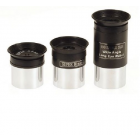Celestron Eyepiece Filter set 1.25"
 Part Exchange & Trade In
Part Exchange & Trade In
Need some more questions answered? Enquire about this product
The 1.25" Eyepiece Filter Set from Celestron contains four assorted filters mounted in black anodized aluminum cells, packed in a plastic case. All four eyepiece filters are threaded to fit most 1.25" eyepieces and accessories. The cells of each filter are double-threaded so that they can be stacked in different combinations. They offer a full 26 mm clear aperture. This filter set includes: ND-96-0.3 Neutral Density, #12 Deep Yellow, #21 Orange, and #80A Blue filters.
Celestron's filters are made of solid plane parallel glass with an anti-reflection coating to help prevent glare and aberrations. Not only are these highly useful filters and combinations, but they also provide an economical way to add versatility to your filter collection.
#21 Orange Filter
Moon - Greatly enhances lunar features. Jupiter - Improves appearance and detail revealed in structure of Jovian belts. Enhances viewing of festoons and polar regions. Mars - Reduces light from the blue and green areas which darken the maria, oases and canal markings, while lightening the orange-hued desert regions. Also sharpens the boundaries of yellow dust clouds. Mercury - Reduces the brightness of blue sky during daylight observing, to reveal surface features. Saturn - Improves structure of the Saturnian bands and highlights blue polar regions. Venus - Use during daylight observing to reduce brightness of blue sky. Comets - Enhances definition of comet dust tails and heads in larger telescopes (11" and greater aperture). Solar - When using a Celestron Mylar Solar Filter, adding this orange filter will give true color rendition.
#80A Light Blue Filter
Moon - Enhance lunar detail. Jupiter - Enhance the boundaries between the reddish belts and adjacent bright zones. Useful for viewing the Great Red Spot. Mars - Very useful during the violet clearing. Helpful in studying surface features and polar caps. Mercury - Improve observation of dusky surface markings at twilight, when the planet is near the horizon. Saturn - Enhance low-contrast features between the belts and zones. Venus - Useful for increased contrast of dark shadings in upper Venusian clouds. Comets - Bring out the best definition in comet gas tails.
#12 Deep Yellow
Moon - Enhances the lunar features. Jupiter - Penetrates and darkens the atmospheric currents that contain low-hue blue tones. It enhances the orange and red features of the belts and zones. It is useful for studies of the polar regions. Mars - Reduces the light from the blue and green areas which darken the marias, oases and canal markings while lightening the orange-hued desert regions. It also sharpens the boundaries of yellow dust clouds. Neptune - Will improve detail in larger telescopes such as an 11" or larger apertures. Saturn - Penetrates and darkens the atmospheric currents containing low-hue blue tones. It enhances the orange and red features of the belts and zones. Uranus - improves detail in larger telescopes such as an 11" or larger apertures. Venus - Reveals low-contrast surface features. Comets - Enhances the definition in comet tails.
ND-96-0.3 Neutral Density Filter
Moon - Excellent for reducing irradiation, glare and subject brightness. Colors are unaltered, as light is transmitted uniformly over the entire spectrum. Each model performs somewhat differently, depending on the brightness of the moon. Planets - Stacking in combination with color filters lowers transmission, but retains true color balance for specific applications. Reduces glare on brighter planets and minimizes irradiation. Binary (Double) Stars - Helpful in splitting binary stars, because it reduces glare and diffraction effects around the brighter star of the binary pair.

 Free UK Delivery
Free UK Delivery Finance Available
Finance Available UK Stock
UK Stock Special Offers
Special Offers



















